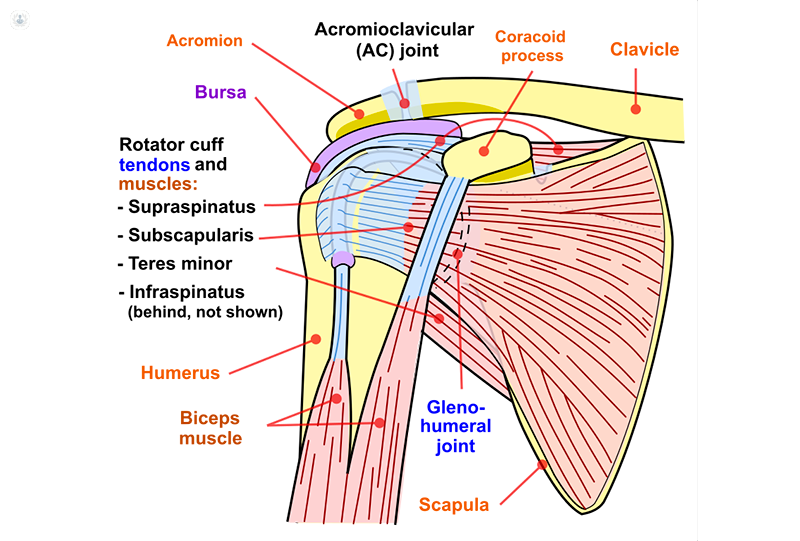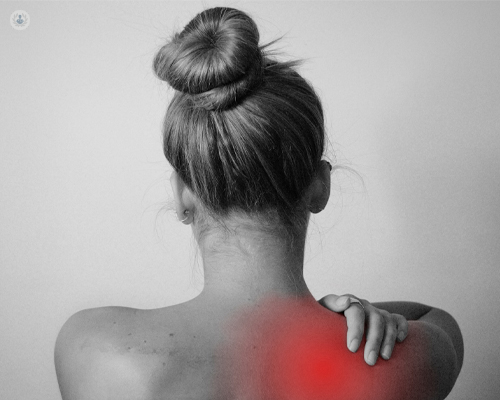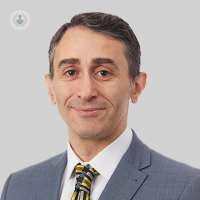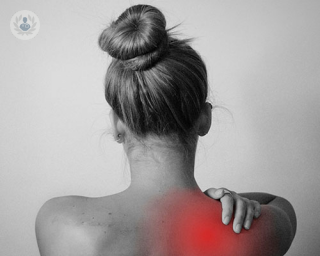Supraspinatus tendon tear
Mr Omar Haddo - Orthopaedic surgery
Created on: 02-07-2014
Updated on: 04-21-2017
Edited by: Aoife Maguire
What is a supraspinatus tendon tear?
A supraspinatus tendon tear is a tear or rupture of the tendon of the supraspinatus muscle, which is located at the back of the shoulder. It is one of the most frequently damaged tendons. It usually develops alongside other rotator cuff muscle tears, which may be the result of trauma or repeated micro-trauma. The tear may be a partial or full thickness tear. A partial tear causes incomplete disruption to the muscle fibres while full thickness tears provoke complete disruption of muscle fibres.

What are the symptoms?
Symptoms of a supraspinatus tear include:
- Pain when lifting and lowering your arm
- Pain when you lie on the injured shoulder
- Stiffness or burning sensation in the shoulder
- Limited range of movement, making it difficult to raise arm above the shoulder.
Usually a tear due to an injury will produce immediate intense pain and weakness in the arm. In cases of a degenerated tear, pain is mild at first and increases gradually over time. The pain from either tear may lead to sleep interruptions/disruption and make daily tasks such as putting on a jacket difficult. It is extremely important to seek medical advice if you are experiencing the symptoms above. Injuries in the rotator cuff can lead to loss of motion or weakness without treatment.
How is it diagnosed?
A clinical diagnosis of your shoulder will include questions about how long you have had the pain for, whether there are certain movements that make the pain worse, and whether you have had similar problems in the past. The practitioner will perform orthopaedic movement tests in order to assess the injury. These tests will involve the patient being asked to move their arm in several directions in order to demonstrate their range of motion and also involve testing arm strength.
It can be difficult to diagnose a supraspinatus tear because there are many other conditions with similar symptoms, including other types of shoulder tears in the rotator cuff, SLAP tear, or inflammatory conditions such as arthritis.
In addition to an examination, your GP may recommend some scans, such as:
- X-ray– to exclude conditions such as sclerosis
- Ultrasound – to quickly view the tendons in your shoulder and compare them to your other shoulder
- MRI – to show the tendon and detect any tears or inflammation.
What are the main causes?
A supraspinatus tear can either be acute or degenerative. An acute tear is one which occurs immediately/develops immediately, due to lifting a heavy object, falling on your shoulder or dislocating your shoulder. An acute tear often develops alongside other injuries, such as a dislocated shoulder.
A degenerative tear is one which develops slowly, due to the tendon wearing down over time. This type of tear increases with age and if only present in one shoulder, the likelihood of a tear developing in the other shoulder is increased.
What are the main risk factors?
You’re more likely to be at risk of developing a supraspinatus tear if:
- You’re over the age of 40
- You lift heavy objects or weights on a regular basis
- You do work which involves lifting your arms, such as painting, plumbing and carpentry.
- You play overhead sports such as tennis, cricket or baseball.
- You smoke.
There are some other factors which may increase the risk of suffering from a supraspinatus tear. Other personal risk factors include:
- Being male; males are more at risk than females.
- Genetics.
- BMI (body mass index) - people with high BMIs are more at risk.
- Lack of blood supply

Can a supraspinatus tendon tear be prevented?
Daily shoulder exercises can strengthen the muscles in your shoulder and help prevent future injury. A physiotherapist can advise you on what exercises will strengthen the back of the shoulder in addition to other parts of the shoulder.
How is a supraspinatus tendon tear treated?
A supraspinatus tear can be treated with medication, physical therapy, steroid injections, or surgery.
- Medication may include pain-relief and anti-inflammatory drugs to reduce swelling in the shoulder.
- Physical therapy involves advice on exercises to carry out which restore flexibility and strength to your shoulder. This is a common form of treatment, both for minor shoulder injuries and for patients recovering from shoulder surgery.
- Steroid injections are sometimes recommended to provide short-term pain relief if medication hasn’t worked.

Is surgery necessary?
Surgery may be considered if the tendon has been badly torn and is unlikely to heal on its own. Surgery might involve reattaching the tendon to the bone, or transferring a nearby tendon to replace the damaged one. In extreme cases, surgery might involve replacing the shoulder joint.
Rotator cuff surgery is recommended for full thickness tears or when non-surgical methods are unsuccessful for those who are experiencing partial thickness tears. Treatment aims to strengthen the shoulder and to relieve pain caused by the tear. Surgery is recommended for people who need to use their arm for work or sports, to aid healing and prevent further tears.
What is recovery from rotator cuff surgery like?
It usually takes six to eight weeks for the tendon to heal to the bone. However, complete recovery time depends on the tear size. Small tears normally take around four months to heal completely. For large, severe tears, healing time is more varied. They may heal within six months or take as long as twelve months.
It is normally safe to return to most activities around 12 weeks after surgery. However, participation in vigorous sports such as football, tennis, and basketball is discouraged until four to six months after undergoing surgery.


